Prove that:
$2 \sin ^{-1} \frac{3}{5}-\tan ^{-1} \frac{17}{31}=\frac{\pi}{4}$
To Prove: $2 \sin ^{-1} \frac{3}{5}-\tan ^{-1} \frac{17}{31}=\frac{\pi}{4}$
Formula Used:
1) $2 \sin ^{-1} x=\sin ^{-1}\left(2 x x \sqrt{1-x^{2}}\right)$
2) $\tan ^{-1} x+\tan ^{-1} y=\tan ^{-1}\left(\frac{x+y}{1-x y}\right)$ where $x y<1$
Proof:
$\mathrm{LHS}=2 \sin ^{-1} \frac{3}{5}-\tan ^{-1} \frac{17}{31} \ldots$ (1)
$2 \sin ^{-1} \frac{3}{5}=\sin ^{-1}\left(2 \times \frac{3}{5} \times \sqrt{1-\left(\frac{3}{5}\right)^{2}}\right)$
$=\sin ^{-1}\left(\frac{6}{5} \times \frac{4}{5}\right)$
$=\sin ^{-1} \frac{24}{25} \ldots$ (2)
Substituting $(2)$ in $(1)$, we get
$\mathrm{LHS}=\sin ^{-1} \frac{24}{25}-\tan ^{-1} \frac{17}{31} \ldots$ (3)
Let $\sin \theta=\frac{24}{25}$
Therefore $\theta=\sin ^{-1} \frac{24}{25} \ldots$ (4)

From the figure, $\tan \theta=\frac{24}{7}$
$\Rightarrow \theta=\tan ^{-1} \frac{24}{7} \ldots$ (5)
From (4) and (5),
$\sin ^{-1} \frac{24}{25}=\tan ^{-1} \frac{24}{7} \ldots$ (6)
Substituting (6) in (3), we get
$\mathrm{LHS}=\tan ^{-1} \frac{24}{7}-\tan ^{-1} \frac{17}{31}$
$=\tan ^{-1}\left(\frac{\frac{24}{7}-\frac{17}{31}}{1+\left(\frac{24}{7} \times \frac{17}{31}\right)}\right)$
$=\tan ^{-1}\left(\frac{744-119}{217+408}\right)$
$=\tan ^{-1} \frac{625}{625}$
$=\tan ^{-1} 1$
$=\frac{\pi}{4}$
$=\mathrm{RHS}$
Therefore, LHS = RHS
Hence proved.
